1978 FIFA World Cup
The 1978 FIFA World Cup, the 11th staging of the FIFA World Cup, quadrennial international football world championship tournament, was held in Argentina between 1 and 25 June.
| Copa Mundial de Fútbol Argentina '78 | |
|---|---|
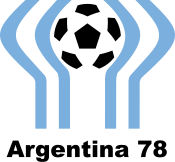 1978 FIFA World Cup official logo | |
| Tournament details | |
| Host country | Argentina |
| Dates | 1–25 June |
| Teams | 16 (from 5 confederations) |
| Venue(s) | 6 (in 5 host cities) |
| Final positions | |
| Champions | |
| Runners-up | |
| Third place | |
| Fourth place | |
| Tournament statistics | |
| Matches played | 38 |
| Goals scored | 102 (2.68 per match) |
| Attendance | 1,545,791 (40,679 per match) |
| Top scorer(s) | |
| Best young player | |
| Fair play award | |
The Cup was won by the host nation, Argentina, who defeated the Netherlands 3–1 in the final, after extra time. The final was held at River Plate's home stadium, Estadio Monumental, in the Argentine capital of Buenos Aires. This win was the first World Cup title for Argentina, who became the fifth team (after Uruguay, Italy, England and West Germany) to be both hosts and world champions. Argentina, the Netherlands and Brazil were the gold, silver and bronze medalists, respectively. Iran and Tunisia made their first appearances in the tournament. This was also the last World Cup tournament to use the original inclusion of 16 teams. Since the first World Cup in 1930, only 15 teams (plus the host, who automatically qualified) had been allowed to qualify (the reigning title holders also received automatic qualification from 1934 through 2002); but for the next World Cup, in Spain, FIFA expanded that tournament to 24 teams.
The official match ball was the Adidas Tango.
Host selection
Argentina was chosen as the host nation by FIFA on 6 July 1966 in London, England. Mexico withdrew from the bidding process after having been awarded the 1970 competition two years earlier.
.jpg)
The logo is based on President Juan Perón's signature gesture: a salute to the crowd with both arms extended above his head. This was one of the most famous, populist images of Perón. The design was created in 1974, two years prior to the military coup in 1976. The military leadership were aware that the World Cup's logo symbolized Perón's gesture, and they tried to change the competition's logo. At this point, the design was already broadly commercialized and the merchandise had already been made: a forced modification "would trigger a sea of lawsuits against the country", so the military had no option but to comply.[2]
Qualification

England, Belgium, Czechoslovakia (the European champions) and the Soviet Union failed to qualify for the second World Cup in succession, losing out to Italy, the Netherlands, Scotland and Hungary respectively. 1974 Quarter-finalists East Germany and Yugoslavia were eliminated by Austria and Spain and thus also failed to qualify for the finals, along with Bulgaria which failed to qualify for the first time since 1958 after losing to France. Bolivia's win meant Uruguay failed to qualify for the first time since 1958. Newcomers to the finals were Iran and Tunisia; Austria qualified for the first time since 1958, while France, Spain and Hungary were back for the first time since 1966. Peru and Mexico returned after missing the previous tournament. For the first time, more than 100 nations entered the competition.[3]
Controversy
A controversy surrounding the 1978 World Cup was that Argentina had undergone a military coup only two years before the cup, which installed a dictatorship known as the National Reorganization Process. Less than a year before the World Cup, in September 1977, Interior Minister General Albano Harguindeguy, stated that 5,618 people had recently disappeared. The infamous Higher School of Mechanics of the Navy (known by its acronym ESMA) held concentration camp prisoners of the Dirty War and those held captive reportedly could hear the roars of the crowd during matches held at River Plate's Monumental Stadium, located only a mile away;[4] prompting echoes of Hitler's and Mussolini's alleged political manipulation of sports during the 1936 Berlin Olympics and 1934 FIFA World Cup.[5] Because of the political turmoil, some countries, most notably the Netherlands, considered publicly whether they should participate in the event. Despite this, all teams eventually took part without restrictions. Allegations that Dutch star Johan Cruyff refused to participate because of political convictions were denied by him 30 years later.[6] More controversy surrounded the host, Argentina, as all of their games in the first round kicked off at night, giving the Argentines the advantage of knowing where they stood in the group. This issue would arise again in Spain 1982, which prompted FIFA to change the rules so that the final two group games in subsequent World Cups would be played simultaneously.
Argentina's controversial and favorable decisions in their matches have caused many to view their eventual win as illegitimate; many cite the political climate and worldwide pressure on the Argentine government as the reason for these decisions. Desperate to prove their stability and prominence to the world after their coup two years earlier, the government used whatever means necessary to ensure that the team would progress far in the tournament.
Suspicions of match fixing arose even before the tournament began; Lajos Baróti, the head coach of Argentina's first opponents, Hungary, said that "everything, even the air, is in favor of Argentina".[7] He also talked about the financial imperative to have Argentina win the World Cup: "The success of Argentina is financially so important to the tournament".[7]
From Will Hersey's article "Remembering Argentina 1978: The Dirtiest World Cup of All Time":
"The other teams in Argentina and Hungary’s group were the much-fancied France and Italy, establishing the tournament’s toughest qualifying section. After the victory against Hungary, one junta official remarked to Luque, that "this could turn out to be the group of death as far as you are concerned". It was delivered with a smile.
"Uppermost in my mind was that earlier that day, the brother of a close friend of mine had disappeared", recalled Luque. "His body was later found by villagers on the banks of the River Plate with concrete attached to his legs. At that time, opponents of the regime were sometimes thrown out of aeroplanes into the sea"."[7]
In their second group stage game against France, Argentina were the beneficiaries of multiple favourable calls. After France was denied what looked to be a clear penalty in the first half, an anonymous French player claimed to have heard the referee tell Daniel Passarella (the player who committed the foul), "Don't do that again please, or I might have to actually give it next time."[8]
Further accusations have surrounded the game Argentina and Peru played in the second round of the tournament. Argentina needed to win by a margin of four goals to proceed to the final and did so by defeating Peru by 6–0. There were claims that the authoritarian Argentine military government interfered to ensure Argentina would defeat Peru through intimidation, though these were denied by the Peruvian captain and several Peruvian players.[9] Some accusations originated in the Brazilian media and pointed to the fact that the Peruvian goalkeeper had been born in Argentina.[10][11] There was also an alleged deal, reported by the British media as an anonymous rumour, that involved the delivery of a large grain shipment to Peru by Argentina and the unfreezing of a Peruvian bank account that was held by the Argentine Central Bank.[12] Another alleged deal, published by a Colombian drug lord in a controversial book, involved the Peruvian team being bribed without any political implications.[9] A third alleged deal, claimed by a Peruvian leftist politician, encompassed sending 13 Peruvian dissidents exiled in Argentina back to Peru.[13] On top of the contradictions between stories, no evidence is shown in any case.
Three months before the World Cup, Argentina had beaten Peru 3–1 in Lima, head to head record was 15–3 in favour of the hosting nation and Peru had never beaten Argentina away from home. However, Peru had conceded only 6 goals in their previous 5 games in the World Cup. During the first half, Peru hit the post twice after two counters when the game was 0–0. Argentina managed to get ahead 2–0 before the end of the first 45 minutes. During the second half, Argentina was ahead 4–0 when Peru had another clear chance. Argentina kept attacking and scored twice more, making it 6–0 and surpassing the needed margin.
There was also some domestic controversy as well, as Argentine manager César Luis Menotti did not call up the then-17-year-old Argentinos Juniors local star Diego Maradona, as Menotti felt Maradona was too young to handle the pressures of such an important tournament on home soil and that the expectations of the team's performance would probably revolve around the Buenos Aires-born youngster.[14] In addition, Maradona's traditional position of number 10 (play-making attacking mid-fielder) was taken by Mario Kempes, who ended up as the Best Player and Top Goal Scorer.
Format
The format of the competition stayed the same as in 1974: 16 teams qualified, divided into four groups of four. Each group played a round-robin with two points for a win and one for a draw, and goal difference used to separate teams level on points. The top two teams in each group would advance to the second round, where they would be split into two groups of four. The winners of each group would play each other in the final, and the second-place finishers in the third place match. For the 1978 World Cup, FIFA introduced the penalty shoot-out as a means of determining the winner in knockout stages should the match end on a draw after 120 minutes. The method, however, was not put in practice as both the third-place match and the final were decided before 120 minutes. The first World Cup to feature a penalty shoot-out was the 1982 World Cup, in the semifinal match between France and West Germany.
Summary
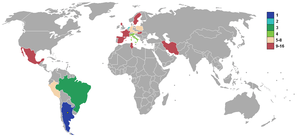
First round
The first round produced several surprises. Poland won Group 2 ahead of world champions West Germany, after holding the Germans to a goalless draw and then beating Tunisia and Mexico. The Germans then thrashed Mexico 6–0, and finally played out a second goalless draw against Tunisia. Although they failed to qualify for the second round, Tunisia made history by beating Mexico 3–1 while trailing 0–1 at half time. It was the first time that any African team had won a match at the World Cup finals.
Peru pushed the Netherlands into second place in Group 4, where Scotland missed out on goal difference for the second successive tournament. Teófilo Cubillas was outstanding for Peru, scoring twice against Scotland in Peru's 3–1 win and hitting a hat-trick in their 4–1 victory over newcomers Iran. Rob Rensenbrink of the Netherlands also scored three times against Iran, scoring all the goals as the Dutch won 3–0. Scotland drew with Iran 1–1 and the only highlight of their campaign was a 3–2 victory over the Netherlands in their final group game which was not enough to prevent elimination. Iran, the reigning Asian champions, went out of the tournament winless. Rensenbrink's goal against Scotland was the 1000th goal of World Cup history. Scotland's Willie Johnston was expelled from the World Cup after he was found to have taken a banned stimulant during the opening game against Peru.
The biggest surprise of all came in Group 3, where Austria finished ahead of Brazil. The Austrians beat Spain and Sweden, while Brazil were held to draws by the same two teams. The draw between Brazil and Sweden was especially controversial; Welsh referee Clive Thomas awarded Brazil a very late corner kick, and Zico directly headed the kick into the net; but Thomas blew for time before Zico made contact with the ball, and the goal was disallowed. The Brazilian players were not happy with the decision, but the final result remained a 1–1 draw. Heading into their final group game, Brazil needed to beat Austria to be certain of advancing to the second round and managed a 1–0 win thanks to a goal from Roberto Dinamite. Brazil and Austria thus finished with the same number of points and the same goal difference, but Austria won the group by virtue of having scored more goals.
Group 1 had the strongest line-up of teams in the first round, featuring Italy, the host Argentina, France and Hungary. The two places in the second round were claimed before the final round of games, with Italy and Argentina both beating France and Hungary. The match between Italy and Argentina decided who topped the group, and a goal from Roberto Bettega midway through the second half was enough to give that honour to Italy. It also forced Argentina to move out of Buenos Aires and play in Rosario.
The 1978 World Cup marked the fourth and last occasion during which a national team did not wear its own kit to play a match (the first being in the 1934 World Cup third place match between Germany and Austria; the second in the 1950 World Cup first round match between Switzerland and Mexico and the third in the 1958 World Cup first round match between West Germany and Argentina). The incident happened during the game between France and Hungary. Both teams arrived at the venue with only their white change kits, resulting in a delayed kickoff while officials went in search of the jerseys of a local team from Mar del Plata, Club Atlético Kimberley; the jerseys had vertical green and white stripes and were worn by France.
Second round
In the all-European Group A, the Netherlands got off to a flying start by thrashing Austria 5–1, Johnny Rep scoring two of their goals. In a rematch of the 1974 final, the Dutch then drew 2–2 with West Germany, who had previously shared a goalless game with Italy. The Italians beat Austria 1–0, and so the Netherlands faced Italy in their last group game knowing that the winners would reach the final. Ernie Brandts scored an 18th-minute own goal to put Italy ahead at half-time, but he made up for his mistake by scoring at the right end in the fifth minute of the second half. Arie Haan got the winner for the Dutch with 15 minutes remaining, and the Netherlands had reached their second successive World Cup Final. In the game known as the miracle of Cordoba, West Germany were surprisingly beaten by Austria 2–3 which marked their end as World Champions.
Group B was essentially a battle between Argentina and Brazil, and it was resolved in controversial circumstances. In the first round of group games, Brazil beat Peru 3–0 while Argentina saw Poland off by a score of 2–0. Brazil and Argentina then played out a tense and violent goalless draw, so both teams went into the last round of matches with three points. Argentina delayed the kick-off of its last match to await the result of the Brazil-Poland encounter. Brazil won by a 3–1 score, meaning Argentina had to beat Peru by four clear goals to reach the final but they managed to do it. Trailing 2–0 at half-time, Peru simply collapsed in the second half, and Argentina eventually won 6–0. As previously noted, rumors suggested that Peru might have been bribed or threatened into allowing Argentina to win the match by such a large margin. However, nothing could be proved, and Argentina met the Netherlands in the final. Brazil took third place from an enterprising Italian side with Nelinho scoring a memorable goal, and were dubbed "moral champions" by coach Cláudio Coutinho, because they did not win the tournament, but did not lose a single match.
Final
The final, Argentina vs Netherlands, was also controversial, as the Dutch accused the Argentines of using stalling tactics to delay the match. The host team came out late and questioned the legality of a plaster cast on René van de Kerkhof's wrist, which the Dutch claimed allowed tension to build in front of a hostile Buenos Aires crowd.
Mario Kempes opened the scoring for the hosts before Dick Nanninga equalized a few minutes from the end. Rob Rensenbrink had a glorious stoppage-time opportunity to win it for the Netherlands but his effort came back off the goal post. Argentina won the final 3–1 after extra time, after Daniel Bertoni scored and Kempes, who finished as the tournament's top scorer with six goals, added his second of the day. The Netherlands, because of the controversial game events, refused to attend the post-match ceremonies after the match ended.[15] They had lost their second consecutive World Cup final, both times to the host nation, after losing to West Germany in 1974. Argentina won 5 games but became the first team to win the World Cup after failing to win two matches, where they had lost to Italy in the first round and drawn with Brazil in the second round. Four years later, Italy would win the next World Cup despite failing to win three games.
Mascot
The official mascot of this World Cup was Gauchito, a boy wearing an Argentina kit. His hat (with the words ARGENTINA '78), neckerchief, and whip are typical of gauchos.
Venues
In 1972, eight venues were preselected, with six that has been in 1978 plus La Plata and Tucuman. The city of the diagonals promised a "one-of-a-kind Stadium" but by 1974 it was scrapped by internal bids. Note, the Estadio Ciudad de La Plata was completed in 2003. In the case of Tucuman, an ambitious stadium of 70,000 spectators had been promised in Horco Molle, similar to the current Racing Club de Avellaneda stadium, along with the roof . In 1974 the Tucuman venue was temporarily suspended and in 1975 it was decommissioned, given the intensity of the actions of the guerrillas and the Armed Forces in the province.[16]
Of the six venues used, the Estadio Monumental in Buenos Aires was the largest and most used venue, hosting nine total matches, including the final match. The Carreras Stadium in Cordoba hosted eight matches, the stadiums in Mendoza, Rosario and Mar del Plata each hosted six matches and the Jose Amalfitani stadium in Buenos Aires hosted three matches- bringing the Argentine capital and largest city’s total to 12- nearly a third of all the matches played. The Minella stadium in Mar del Plata was heavily criticized due to its terrible pitch, which was deemed "nearly unplayable"; whereas the Amalfitani stadium in Buenos Aires, the least used stadium for this tournament, was praised for its very good pitch.[17] Brazil was forced by tournament organizers to play all three of its first group matches in Mar del Plata; there had been rumors and allegations of the organizers deliberately sabotaging the Minella stadium's pitch to weaken Brazil's chances of success.
| Buenos Aires | Córdoba | ||
|---|---|---|---|
| Estadio Monumental | Estadio José Amalfitani | Estadio Chateau Carreras | |
| Capacity: 74,624 | Capacity: 49,318 | Capacity: 46,986 | |
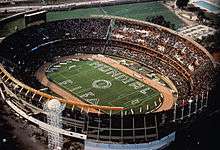 |
_1.jpg) | ||
| Mar del Plata | Rosario | Mendoza | |
| Estadio José María Minella | Estadio Gigante de Arroyito | Estadio Ciudad de Mendoza | |
| Capacity: 43,542 | Capacity: 41,654 | Capacity: 34,954 | |
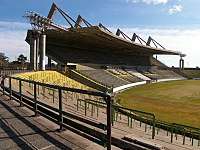 |
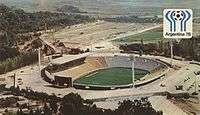 | ||
Match officials
- AFC

.svg.png)

- CAF

- CONCACAF

- CONMEBOL

.svg.png)

.svg.png)

- UEFA
Squads
For a list of all squads that appeared in the final tournament, see 1978 FIFA World Cup squads.
Seeding
| Pot 1 | Pot 2 | Pot 3 | Pot 4 |
|---|---|---|---|
|
First round
Group 1

| Pos | Team | Pld | W | D | L | GF | GA | GD | Pts | Qualification |
|---|---|---|---|---|---|---|---|---|---|---|
| 1 | 3 | 3 | 0 | 0 | 6 | 2 | +4 | 6 | Advance to second round | |
| 2 | 3 | 2 | 0 | 1 | 4 | 3 | +1 | 4 | ||
| 3 | 3 | 1 | 0 | 2 | 5 | 5 | 0 | 2 | ||
| 4 | 3 | 0 | 0 | 3 | 3 | 8 | −5 | 0 |
| 2 June 1978 | |||
| Italy | 2–1 | Estadio José María Minella, Mar del Plata | |
| Argentina | 2–1 | Estadio Monumental, Buenos Aires | |
| 6 June 1978 | |||
| Italy | 3–1 | Estadio José María Minella, Mar del Plata | |
| Argentina | 2–1 | Estadio Monumental, Buenos Aires | |
| 10 June 1978 | |||
| France | 3–1 | Estadio José María Minella, Mar del Plata | |
| Argentina | 0–1 | Estadio Monumental, Buenos Aires | |
Group 2

| Pos | Team | Pld | W | D | L | GF | GA | GD | Pts | Qualification |
|---|---|---|---|---|---|---|---|---|---|---|
| 1 | 3 | 2 | 1 | 0 | 4 | 1 | +3 | 5 | Advance to second round | |
| 2 | 3 | 1 | 2 | 0 | 6 | 0 | +6 | 4 | ||
| 3 | 3 | 1 | 1 | 1 | 3 | 2 | +1 | 3 | ||
| 4 | 3 | 0 | 0 | 3 | 2 | 12 | −10 | 0 |
| 1 June 1978 | |||
| West Germany | 0–0 | Estadio Monumental, Buenos Aires | |
| 2 June 1978 | |||
| Tunisia | 3–1 | Estadio Gigante de Arroyito, Rosario | |
| 6 June 1978 | |||
| West Germany | 6–0 | Estadio Chateau Carreras, Córdoba | |
| Poland | 1–0 | Estadio Gigante de Arroyito, Rosario | |
| 10 June 1978 | |||
| West Germany | 0–0 | Estadio Olímpico Chateau Carreras, Córdoba | |
| Poland | 3–1 | Estadio Gigante de Arroyito, Rosario |
Group 3
| Pos | Team | Pld | W | D | L | GF | GA | GD | Pts | Qualification |
|---|---|---|---|---|---|---|---|---|---|---|
| 1 | 3 | 2 | 0 | 1 | 3 | 2 | +1 | 4 | Advance to second round | |
| 2 | 3 | 1 | 2 | 0 | 2 | 1 | +1 | 4 | ||
| 3 | 3 | 1 | 1 | 1 | 2 | 2 | 0 | 3 | ||
| 4 | 3 | 0 | 1 | 2 | 1 | 3 | −2 | 1 |
| 3 June 1978 | |||
| Austria | 2–1 | Estadio José Amalfitani, Buenos Aires | |
| Brazil | 1–1 | Estadio José Maria Minella, Mar del Plata | |
| 7 June 1978 | |||
| Austria | 1–0 | Estadio José Amalfitani, Buenos Aires | |
| Brazil | 0–0 | Estadio José Maria Minella, Mar del Plata | |
| 11 June 1978 | |||
| Spain | 1–0 | Estadio José Amalfitani, Buenos Aires | |
| Brazil | 1–0 | Estadio José Maria Minella, Mar del Plata |
Group 4

| Pos | Team | Pld | W | D | L | GF | GA | GD | Pts | Qualification |
|---|---|---|---|---|---|---|---|---|---|---|
| 1 | 3 | 2 | 1 | 0 | 7 | 2 | +5 | 5 | Advance to second round | |
| 2 | 3 | 1 | 1 | 1 | 5 | 3 | +2 | 3 | ||
| 3 | 3 | 1 | 1 | 1 | 5 | 6 | −1 | 3 | ||
| 4 | 3 | 0 | 1 | 2 | 2 | 8 | −6 | 1 |
| 3 June 1978 | |||
| Peru | 3–1 | Estadio Chateau Carreras, Córdoba | |
| Netherlands | 3–0 | Estadio Ciudad de Mendoza, Mendoza | |
| 7 June 1978 | |||
| Scotland | 1–1 | Estadio Chateau Carreras, Córdoba | |
| Netherlands | 0–0 | Estadio Ciudad de Mendoza, Mendoza | |
| 11 June 1978 | |||
| Peru | 4–1 | Estadio Chateau Carreras, Córdoba | |
| Scotland | 3–2 | Estadio Ciudad de Mendoza, Mendoza |
Second round
Group A
| Pos | Team | Pld | W | D | L | GF | GA | GD | Pts | Qualification |
|---|---|---|---|---|---|---|---|---|---|---|
| 1 | 3 | 2 | 1 | 0 | 9 | 4 | +5 | 5 | Advance to final | |
| 2 | 3 | 1 | 1 | 1 | 2 | 2 | 0 | 3 | Advance to third place play-off | |
| 3 | 3 | 0 | 2 | 1 | 4 | 5 | −1 | 2 | ||
| 4 | 3 | 1 | 0 | 2 | 4 | 8 | −4 | 2 |
| 14 June 1978 | |||
| Austria | 1–5 | Estadio Chateau Carreras, Córdoba | |
| Italy | 0–0 | Estadio Monumental, Buenos Aires | |
| 18 June 1978 | |||
| Netherlands | 2–2 | Estadio Chateau Carreras, Córdoba | |
| Italy | 1–0 | Estadio Monumental, Buenos Aires | |
| 21 June 1978 | |||
| Austria | 3–2 | Estadio Chateau Carreras, Córdoba | |
| Italy | 1–2 | Estadio Monumental, Buenos Aires |
Group B
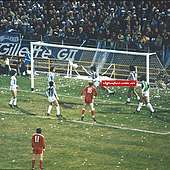
| Pos | Team | Pld | W | D | L | GF | GA | GD | Pts | Qualification |
|---|---|---|---|---|---|---|---|---|---|---|
| 1 | 3 | 2 | 1 | 0 | 8 | 0 | +8 | 5 | Advance to final | |
| 2 | 3 | 2 | 1 | 0 | 6 | 1 | +5 | 5 | Advance to third place play-off | |
| 3 | 3 | 1 | 0 | 2 | 2 | 5 | −3 | 2 | ||
| 4 | 3 | 0 | 0 | 3 | 0 | 10 | −10 | 0 |
| 14 June 1978 | |||
| Peru | 0–3 | Estadio Ciudad de Mendoza, Mendoza | |
| Argentina | 2–0 | Estadio Gigante de Arroyito, Rosario | |
| 18 June 1978 | |||
| Peru | 0–1 | Estadio Ciudad de Mendoza, Mendoza | |
| Argentina | 0–0 | Estadio Gigante de Arroyito, Rosario | |
| 21 June 1978 | |||
| Poland | 1–3 | Estadio Ciudad de Mendoza, Mendoza | |
| Argentina | 6–0 | Estadio Gigante de Arroyito, Rosario |
Knockout stage
Final
| Argentina | 3–1 (a.e.t.) | |
|---|---|---|
| Kempes Bertoni |
Report | Nanninga |
Goalscorers
With six goals, Mario Kempes is the top scorer in the tournament. In total, 102 goals were scored by 62 players, with three of them credited as own goals.
- 6 goals
- 5 goals
- 4 goals
- 3 goals
.svg.png)
.svg.png)



- 2 goals
- 1 goal





.svg.png)
.svg.png)








.svg.png)
.svg.png)










.svg.png)
.svg.png)


.svg.png)
.svg.png)

.svg.png)
.svg.png)
.svg.png)



- Own goals
FIFA retrospective ranking
In 1986, FIFA published a report that ranked all teams in each World Cup up to and including 1986, based on progress in the competition, overall results and quality of the opposition.[18][19] The rankings for the 1978 tournament were as follows:
| R | Grp | Team | Pld | W | D | L | GF | GA | GD | Pts | Result |
|---|---|---|---|---|---|---|---|---|---|---|---|
| 1 | 1/B | 7 | 5 | 1 | 1 | 15 | 4 | +11 | 11 | Champion | |
| 2 | 4/A | 7 | 3 | 2 | 2 | 15 | 10 | +5 | 8 | Runners-up | |
| 3 | 3/B | 7 | 4 | 3 | 0 | 10 | 3 | +7 | 11 | Third place | |
| 4 | 1/A | 7 | 4 | 1 | 2 | 9 | 6 | +3 | 9 | Fourth place | |
| 5 | 2/B | 6 | 3 | 1 | 2 | 6 | 6 | 0 | 7 | Eliminated in the second group stage | |
| 6 | 2/A | 6 | 1 | 4 | 1 | 10 | 5 | +5 | 6 | ||
| 7 | 3/A | 6 | 3 | 0 | 3 | 7 | 10 | −3 | 6 | ||
| 8 | 4/B | 6 | 2 | 1 | 3 | 7 | 12 | −5 | 5 | ||
| 9 | 2 | 3 | 1 | 1 | 1 | 3 | 2 | +1 | 3 | Eliminated in the first group stage | |
| 10 | 3 | 3 | 1 | 1 | 1 | 2 | 2 | 0 | 3 | ||
| 11 | 4 | 3 | 1 | 1 | 1 | 5 | 6 | −1 | 3 | ||
| 12 | 1 | 3 | 1 | 0 | 2 | 5 | 5 | 0 | 2 | ||
| 13 | 3 | 3 | 0 | 1 | 2 | 1 | 3 | −2 | 1 | ||
| 14 | 4 | 3 | 0 | 1 | 2 | 2 | 8 | −6 | 1 | ||
| 15 | 1 | 3 | 0 | 0 | 3 | 3 | 8 | −5 | 0 | ||
| 16 | 2 | 3 | 0 | 0 | 3 | 2 | 12 | −10 | 0 |
Notes
- "1978 FIFA World Cup Argentina - Awards". FIFA.com. Fédération Internationale de Football Association. Retrieved 3 February 2019.
- Pablo Llonto, "I Mondiali della vergogna. I campionati di Argentina '78 e la dittatura"("The World Cup of the Shame. Argentina '78 and the dictatorship"), Edizioni Alegre, Rome 2010, p. 38.
- "1978 FIFA World Cup Argentina™ Preliminaries". FIFA.
- Winner, David (21 June 2008). "But Was This The Beautiful Game's Ugliest Moment?". Financial Times. Archived from the original on 11 June 2010. Retrieved 15 June 2014.
- McDonnell, Patrick J. (28 June 2008). "Argentina's bittersweet win". LA Times. Retrieved 7 April 2010.
- Doyle, Paul (16 April 2008). "Kidnappers made Cruyff miss World Cup". The Guardian. London. Retrieved 20 June 2008.
- Hersey, Will (16 June 2018). "Remembering Argentina 1978: The Dirtiest WOrld Cup of All Time". Esquire.
- Spurling, Jon (11 March 2016). "Argentina's 1978 World Cup Run: The Ugly Truth".
- "El capitán de Perú en el 78: 'Pongo la mano en el fuego por mis compañeros'". El Mundo (in Spanish).
- "Keeping the Dark Side of Soccer Away From the City of Light". The New York Times.
- "Niega Videla arreglo de partidos en Argentina 1978" (in Spanish). Excelsior.
- The Independent (15 March 1995). "Bungs and bribes football can't kick this habit". London.
- Roper, Matt (9 February 2012). "Peru senator claims 1978 World Cup game against Argentina was rigged". Daily Mail. London.
- "Summary of Maradona's life". www.vivadiego.com.
- "The Netherlands pay back controversial loss to Argentina". CNN. 4 July 1998. Retrieved 20 April 2010.
- Jon (4 February 2008). "Al sueño de Tucumán lo invadió la frustración".
- "Archived copy". Archived from the original on 2 January 2016. Retrieved 12 June 2015.CS1 maint: archived copy as title (link)
- "page 45" (PDF). Retrieved 2 March 2012.
- "FIFA World Cup: Milestones, facts & figures. Statistical Kit 7" (PDF). FIFA. 26 March 2013. Archived from the original (PDF) on 21 May 2013.
External links
| Wikimedia Commons has media related to 1978 FIFA World Cup. |
- 1978 FIFA World Cup Argentina ™, FIFA.com
- Details at RSSSF
- FIFA Technical Report (Part 1), (Part 2), (Part 3), (Part 4), (Part 5), (Part 6) and (Part 7)
